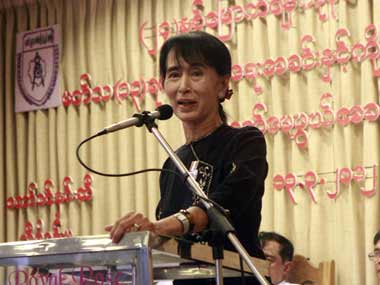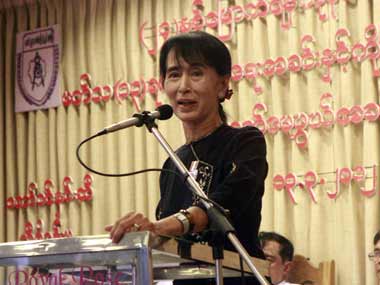The opposition party of Myanmar pro-democracy leader Aung San Suu Kyi has announced that she won a parliamentary seat in Sunday’s by-elections. The victory, if confirmed in official results, marks a milestone in a nation that where the military has ruled almost exclusively for a half-century. Here are some key events in the life of Suu Kyi, who became the face of Myanmar’s struggle for democracy while locked under house arrest for two decades: EARLY LIFE June 19, 1945: Born in Yangon, then called Rangoon. She is the daughter of national hero Gen Aung San and Daw Khin Kyi, also a prominent public figure. July 1947: Aung San and six members of his interim government are assassinated by rivals. Suu Kyi is 2. 1960: After finishing high school, Suu Kyi leaves for further study in New Delhi, where her mother is Burma’s ambassador. She later moves to England to study at Oxford University. [caption id=“attachment_262676” align=“alignleft” width=“380” caption=“Suu Kyi, became the face of Myanmar’s struggle for democracy while locked under house arrest for two decades. AP”]
 [/caption] 1972: Marries Michael Aris, an Oxford University academic. Son Alexander born in 1973, son Kim born in 1977. POLITICAL LIFE April 1988: Suu Kyi returns home to attend to her ailing mother just as pro-democracy protests erupt against the military junta. Her mother dies later that year. 8-11 August, 1988: Mass demonstrations throughout Burma. Security forces open fire on demonstrators. Hundreds are killed. September 1988: Suu Kyi helps found opposition party, the National League for Democracy. June 1989: The government renames the country Myanmar and the capital Yangon. July 1989: Suu Kyi, an increasingly outspoken critic of the junta, and her deputy, Tin Oo, are put under house arrest. May 1990: The junta calls general elections. Suu Kyi’s party wins a landslide victory, but the military refuses to hand over power. October 1991: Suu Kyi is awarded the Nobel Peace Prize for her peaceful struggle against the regime. July 1995: Suu Kyi is released from house arrest but remains in Myanmar, fearing she will never be let back into the country if she leaves. March 1999: Aris, who has not seen his wife since 1995 because the junta repeatedly denied him a visa, dies of cancer in England. September 2000: Suu Kyi is placed under house arrest after attempting to leave Yangon for a political meeting. May 2002: Suu Kyi is released from house arrest. May 2003: Suu Kyi is put back under house arrest. She is taken into “protective custody” after her motorcade is ambushed by a government-backed mob. August 2007: Protests start over fuel price increases, then swell into the largest pro-democracy demonstrations since 1988. The movement was dubbed the “Saffron Revolution” because it was led by saffron-robed Buddhist monks. 11 August, 2009: Suu Kyi’s detention is extended by 18 months when a court convicts her of violating her house arrest by briefly sheltering an American intruder who swam to her house uninvited. 7 November, 2010: Myanmar’s first elections in 20 years. Pro-junta party wins landslide victory in polls critics say were rigged and rampant with fraud. 13 November, 2010: Suu Kyi’s detention expires and she is freed. 18 Jan, 2012: Suu Kyi registers for April 1 by-election, kicking off a campaign that draws ecstatic nationwide support. 1 April, 2012: By-elections to fill 45 seats in the 664-seat parliament. Suu Kyi’s party says she wins a seat, in what would mark her first elected office after two decades as a symbolic opposition leader. AP
[/caption] 1972: Marries Michael Aris, an Oxford University academic. Son Alexander born in 1973, son Kim born in 1977. POLITICAL LIFE April 1988: Suu Kyi returns home to attend to her ailing mother just as pro-democracy protests erupt against the military junta. Her mother dies later that year. 8-11 August, 1988: Mass demonstrations throughout Burma. Security forces open fire on demonstrators. Hundreds are killed. September 1988: Suu Kyi helps found opposition party, the National League for Democracy. June 1989: The government renames the country Myanmar and the capital Yangon. July 1989: Suu Kyi, an increasingly outspoken critic of the junta, and her deputy, Tin Oo, are put under house arrest. May 1990: The junta calls general elections. Suu Kyi’s party wins a landslide victory, but the military refuses to hand over power. October 1991: Suu Kyi is awarded the Nobel Peace Prize for her peaceful struggle against the regime. July 1995: Suu Kyi is released from house arrest but remains in Myanmar, fearing she will never be let back into the country if she leaves. March 1999: Aris, who has not seen his wife since 1995 because the junta repeatedly denied him a visa, dies of cancer in England. September 2000: Suu Kyi is placed under house arrest after attempting to leave Yangon for a political meeting. May 2002: Suu Kyi is released from house arrest. May 2003: Suu Kyi is put back under house arrest. She is taken into “protective custody” after her motorcade is ambushed by a government-backed mob. August 2007: Protests start over fuel price increases, then swell into the largest pro-democracy demonstrations since 1988. The movement was dubbed the “Saffron Revolution” because it was led by saffron-robed Buddhist monks. 11 August, 2009: Suu Kyi’s detention is extended by 18 months when a court convicts her of violating her house arrest by briefly sheltering an American intruder who swam to her house uninvited. 7 November, 2010: Myanmar’s first elections in 20 years. Pro-junta party wins landslide victory in polls critics say were rigged and rampant with fraud. 13 November, 2010: Suu Kyi’s detention expires and she is freed. 18 Jan, 2012: Suu Kyi registers for April 1 by-election, kicking off a campaign that draws ecstatic nationwide support. 1 April, 2012: By-elections to fill 45 seats in the 664-seat parliament. Suu Kyi’s party says she wins a seat, in what would mark her first elected office after two decades as a symbolic opposition leader. AP
Suu Kyi's journey: From house arrest to parliament
FP Archives
• April 2, 2012, 08:09:25 IST
Suu Kyi, became the face of Myanmar’s struggle for democracy while locked under house arrest for two decades. Here are key events from her life.
Advertisement
)